Shaping Poultry Meat Quality Attributes in the Context of Consumer Expectations and Preferences—A Case Study of Poland
Abstract
1. Introduction
- -
- To identify the quality characteristics of meat that determine its choice and the quality characteristics that fail to meet consumers’ expectations of quality;
- -
- The determination of consumer attributes of poultry fillet quality assessment;
- -
- To identify consumer responses to the meat characteristics observed during the purchase, which fail to satisfy their quality expectations, with a particular focus on small and large haematomas;
- -
- To identify consumer behaviours as regards poultry fillets with characteristics that fail to satisfy their expectations and to identify high-quality poultry meat attributes.
2. Materials and Methods
- ➢
- The perception of chicken fillet attributes regarded as meat defects, i.e., dry (D); protruding broken bones (PBB); discolouration on the surface (DS); watery (W); atypical flavour (AF); no defects noticed (NDN); bruising and petechial haemorrhages (BPH); and meat sliminess (MSL),
- ➢
- Responses to the meat defects in the form of small and large hematomas were analysed.
3. Results and Discussion
3.1. Identify Consumer Preferences as Regards the Attributes of Poultry Meat Offered on the Polish Market
3.1.1. Perception of Chicken Fillets Attributes Regarded as Meat Defects
3.1.2. Respondents’ Responses to Meat Defects—Small and Large Hematomas
3.2. Respondents’ Expectations of High-Quality Meat
4. Summary and Conclusions
- The main characteristics of the expected quality of poultry meat are those interpreted by consumers as sensory (appearance–colour) and functional attributes (nutritional value and protein content).
- Analysis of the consumer assessment results demonstrated that, in the respondents’ opinion on the quality of the meat offered on the poultry meat market, the most frequent characteristics that are undesirable and not accepted by consumers include discolourations, bruises and petechial haemorrhages which are clearly visible on both the external and internal fillet surface. Hypothesis No 1 was positively verified.
- When buying poultry meat, consumers pay particular attention to the absence of visible bruises and blood spots on the meat surface and to a uniform colour. Respondents who have bought a fillet with a defect of petechial haemorrhages, irrespective of their size, request a product exchange or cut off the part of the meat with haematomas. Hypothesis No 3 was positively verified. The respondents’ attitudes towards meat with defects, including meat with haematomas, are significantly affected by gender and education (socio-demographic characteristics). The obtained relationships confirmed Hypothesis No 2.
- The expectations declared by consumers with regard to the quality attributes for the poultry meat offered on the market indicate the need for improving its overall appearance by eliminating petechial haemorrhages from the fillet and ensuring a uniform colour all over its surface. Hypothesis No 4 was positively verified.
Author Contributions
Funding
Data Availability Statement
Conflicts of Interest
References
- FAOSTAT 2021. Available online: https://www.tandfonline.com/doi/abs/10.1079/WPS20020013 (accessed on 10 September 2021). [CrossRef]
- Stoś, K.; Rychlik, E.; Woźniak, A.; Ołtarzewski, M. Red and processed meat consumption in Poland. Foods 2022, 11, 3283. [Google Scholar] [CrossRef]
- Adamski, M.; Kużnicka, J.; Milczewska, N. Preferences of consumers for choosing poultry meat. Pol. J. Nat. Sci. 2017, 32, 261–271. [Google Scholar]
- Pellattiero, E.; Tasoniero, G.; Cullere, M.; Gleeson, E.; Baldan, G.; Contiero, B.; Zotte, A.D. Are meat quality traits and sensory attributes in favor of slow-growing chickens? Animals 2020, 10, 960. [Google Scholar] [CrossRef] [PubMed]
- Grunert, K.G.; Hartvig Larsen, H.; Madsen, T.K.; Baadsgaard, A. Market Orientation in Food and Agriculture; Kluwer Academic Press: Boston, MA, USA, 1996. [Google Scholar]
- Grasso, A.C.; Hung, Y.; Olthof, M.R.; Brouwer, I.A.; Verbeke, W. Understanding meat consumption in later life: A segmentation of older consumers in the EU. Food Qual. Prefer. 2021, 93, 104242. [Google Scholar] [CrossRef]
- Courcoux, P. Preference mapping using a latent class vector model. Food Qual. Prefer. 2001, 12, 369–372. [Google Scholar] [CrossRef]
- Semenou, M. Preference study using a latent class approach. Analysis of European preferences for smoked salmon. Food Qual. Prefer. 2007, 18, 720–728. [Google Scholar] [CrossRef]
- Carbonell, L.; Izquierdo, L.; Carbonell, I.; Costell, E. Segmentation of food consumers according to their correlations with sensory attributes projected on preference spaces. Food Qual. Prefer. 2008, 19, 71–78. [Google Scholar] [CrossRef]
- Gracia, A.; Loureiro, M.L.; Nayga, R.M. Consumers’ valuation of nutritional information: A choice experiment study. Food Qual. Prefer. 2009, 20, 463–471. [Google Scholar] [CrossRef]
- Combris, P.; Bazoche, P.; Giraud-Héraud, E.; Issanchou, S. Food choices: What do we learn from combining sensory and economic experiments? Food Qual. Prefer. 2009, 20, 550–557. [Google Scholar] [CrossRef]
- Skunca, D.; Tomasevic, I.; Zdolec, N.; Kolaj, R.; Aleksiev, G.; Djekic, I. Consumer-perceived quality characteristics of chicken meat and chicken meat products in Southeast Europe. Br. Food J. 2017, 119, 1525–1535. [Google Scholar] [CrossRef]
- Vukasovič, T. European meat market trends and consumer preference for poultry meat in buying decision making process. World’s Poult. Sci. J. 2014, 70, 289–302. [Google Scholar] [CrossRef]
- Šedová, I.; Slovák, L.; Ježková, I. Coping with unpleasant knowledge: Meat eating among students of environmental studies. Appetite 2016, 107, 415–424. [Google Scholar] [CrossRef]
- Pinto da Rosa, P.; Pio Ávila, B.; Damé Veber Angelo, I.; Garavaglia Chesini, R.; Albandes Fernandes, T.; da Silva Camacho, J.; Bugoni, M.; Roll, V.F.B.; Gularte, M.A. Impact of different chicken meat production systems on consumers’ purchase perception. Br. Poult. Sci. 2021, 62, 387–395. [Google Scholar] [CrossRef]
- Chen, C.; Chaudhary, A.; Mathys, A. Dietary change scenarios and implications for environmental, nutrition, human health and economic dimensions of food sustainability. Nutrients 2019, 11, 856. [Google Scholar] [CrossRef] [PubMed]
- EFSA Scientific Opinion on the electrical requirements for waterbath stunning equipment applicable for poultry. EFSA J. 2012, 10, 2757. [CrossRef]
- EFSA Panel on Animal Health and Welfare (AHAW); Nielsen, S.S.; Alvarez, J.; Bicout, D.J.; Calistri, P.; Depner, K.; Drewe, J.A.; Garin-Bastuji, B.; Gonzales Rojas, J.L.; Gortázar Schmidt, C.; et al. EFSA Slaughter of animals: Poultry. EFSA J. 2019, 17, 5849. [Google Scholar] [CrossRef]
- European Union. Council Regulation (EC) NO 1099/2009 of 24 September 2009 on the Protection of Animals at the Time of Killing; European Union: Maastricht, The Netherlands, 2009. [Google Scholar]
- Brzozowski, C. Industry Journal of the QAFP Food Quality System—Culinary Chicken and Turkey Breast Meat as Well as Carcasses and Elements of Young Polish Oat Goose; Krajowa Rada Drobiarstwa—Izba Gospodarcza: Warszawa, Poland, 2012; pp. 6–23. (In Polish) [Google Scholar]
- Boguszewski, R.; Hipsz, N. From a paper-based to a computer-aided questionnaire. Comparative analysis of PAPI and CAPI techniques. Przegląd Socjol. 2012, 61, 65–82. (In Polish) [Google Scholar]
- Bradburn, N.M.; Frankel, M.R.; Baker, R.P.; Pergamit, M.R. A comparison of computer-assisted personal interviews (CAPI) with paper-and-pencil (PAPI) interviews. Part of the Discussion Paper Series on National and Longitudinal Study of Youth, Paper No. 9. In Information and Technology in Survey Research; University of Chicago: Chicago, IL, USA, 1991. [Google Scholar]
- De Leeuw, E.; Hox, J.; Snijkers, G. The effect of computer-assisted interviewing on data quality. Int. J. Mark. Res. 1995, 37, 1–19. [Google Scholar] [CrossRef]
- Banach, J.K. Method for complex improvement of the quality of culinary turkey meat in the aspect of the national system Quality Assurance for Food Products. Rozpr. I Monogr. 2013, 186, 9–141. (In Polish) [Google Scholar]
- Szreder, M. Metody I Techniki Sondażowych Badań Opinii; Polskie Wydawnictwo Ekonomiczne: Warsaw, Poland, 2010. (In Polish) [Google Scholar]
- Uikey, K.; Linge, A.A. Consumers Preferences towards Different Types of Foods Consumed at Different Food Outlets: A Correspondence Analysis. Sanshodhan 2023, 12, 54–63. [Google Scholar] [CrossRef]
- Bala, K.; Etikan, I.; Usman, A.G.; Abba, S.I. Artificial-Intelligence-Based Models Coupled with Correspondence Analysis Visualization on ART—Cases from Gombe State, Nigeria: A Comparative Study. Life 2023, 13, 715. [Google Scholar] [CrossRef] [PubMed]
- Gralinska, E.; Vingron, M. Association Plots: Visualizing cluster-specific associations in high-dimensional correspondence analysis biplots. J. R. Stat. Soc. Ser. C Appl. Stat. 2023, 2023, qlad039. [Google Scholar] [CrossRef]
- Greenacre, M. Biplots in practice. J. R. Stat. Soc. Ser. A (Stat. Soc.) 2010, 51, 375–392. [Google Scholar] [CrossRef]
- Florez Ayala, D.H.; Alberton, A.; Ersoy, A. Urban living labs: Pathways of sustainability transitions towards innovative city systems from a circular economy perspective. Sustainability 2022, 14, 9831. [Google Scholar] [CrossRef]
- Dudziak, A.; Stoma, M.; Derkacz, A.J. Circular economy in the context of food losses and waste. Sustainability 2022, 14, 10116. [Google Scholar] [CrossRef]
- Cheng, W.; Xu, Z.; Fan, S.; Zhang, P.; Xia, J.; Wang, H.; Ye, Y.; Liu, B.; Wang, Q.; Wu, Y. Effects of variations in the chemical composition of individual rice grains on the eating quality of hybrid indica rice based on near-infrared spectroscopy. Foods 2022, 11, 2634. [Google Scholar] [CrossRef]
- Fan, X.; Guan, Y.; Bai, Z.; Zhou, W.; Zhu, C. Optimization of Reclamation Measures in a Mining Area by Analysis of Variations in Soil Nutrient Grades under Different Types of Land Usage—A Case Study of Pingshuo Coal Mine, China. Land 2022, 11, 321. [Google Scholar] [CrossRef]
- Liu, S.; Liao, Q.; Xiao, M.; Zhao, D.; Huang, C. Spatial and temporal variations of habitat quality and its response of landscape dynamic in the three gorges reservoir area, China. Int. J. Environ. Res. Public Health 2022, 19, 3594. [Google Scholar] [CrossRef]
- Tomanić, D.; Božin, B.; Kladar, N.; Stanojević, J.; Čabarkapa, I.; Stilinović, N.; Apić, J.; Božić, D.D.; Kovačević, Z. Environmental bovine mastitis pathogens: Prevalence, antimicrobial susceptibility, and sensitivity to Thymus vulgaris L., Thymus serpyllum L., and Origanum vulgare L. essential oils. Antibiotics 2022, 11, 1077. [Google Scholar] [CrossRef]
- Kuttappan, V.A.; Lee, Y.S.; Erf, G.F.; Meullenet, J.-F.C.; McKee, S.R.; Owens, C.M. Consumer acceptance of visual appearance of broiler breast meat with varying degrees of white striping. Poult. Sci. 2012, 91, 1240–1247. [Google Scholar] [CrossRef]
- Żywica, R.; Charzyńska, D.G.; Banach, J.K. Effect of electric stunning of chickens on meat colour using device constructed by the authors. Żywność. Nauka. Technologia. Jakość 2011, 1, 52–67. (In Polish) [Google Scholar] [CrossRef]
- Lines, J.A.; Raj, A.B.M.; Wotton, S.B.; O’Callaghan, M.; Knowles, T.G. Head-only electrical stunning of poultry using a waterbath: A feasibility study. Br. Poult. Sci. 2011, 52, 432–438. [Google Scholar] [CrossRef] [PubMed]
- Sirri, F.; Petracci, M.; Zampiga, M.; Meluzzi, A. Effect of EU electrical stunning conditions on breast meat quality of broiler chickens. Poult. Sci. 2017, 96, 3000–3004. [Google Scholar] [CrossRef] [PubMed]
- Fletcher, D.I. Poultry meat quality. World’s Poult. Sci. J. 2002, 58, 131–145. [Google Scholar] [CrossRef]
- Żywica, R.; Banach, J.K. System for Turkey Stunning. Patent PL No 211078, 30 April 2012. (In Polish). [Google Scholar]
- Żywica, R.; Banach, J.K. A Method of Stunning. Poultry. Patent Patent PL No P.390449, 29 November 2013. (In Polish). [Google Scholar]
- Lambooij, E.; Reimert, H.G.M.; Hindle, V.A. Evaluation of head-only stunning for practical application: Assessment of neural and meat quality parameters. Poult. Sci. 2010, 89, 2551–2558. [Google Scholar] [CrossRef]
- Wideman, N.; O’Bryan, C.A.; Crandall, P.G. Factors affecting poultry meat colour and consumer preferences—A review. World’s Poult. Sci. J. 2016, 72, 353–366. [Google Scholar] [CrossRef]
- Wilkins, L.J.; Brown, S.N.; Phillips, A.J.; Warriss, P.D. Variation in the colour of broiler breast fillets in the UK. Br. Poult. Sci. 2000, 41, 308–312. [Google Scholar] [CrossRef]
- Sismanoglou, A.; Tzimitra-Kalogianni, I. Consumer perception of poultry meat in Greece. World’s Poult. Sci. J. 2011, 67, 269–276. [Google Scholar] [CrossRef]
- Banach, J.K. Attitudes and consumer behavior on the market of poultry meat produced within system Quality Assurance for Food Products. In Monografia: Wybrane Problemy Jakości Żywności; Żuchowska-Grzywacz, M., Zieliński, R., Eds.; Wyd. UT-H Radom: Radom, Poland, 2018; pp. 155–164. [Google Scholar]

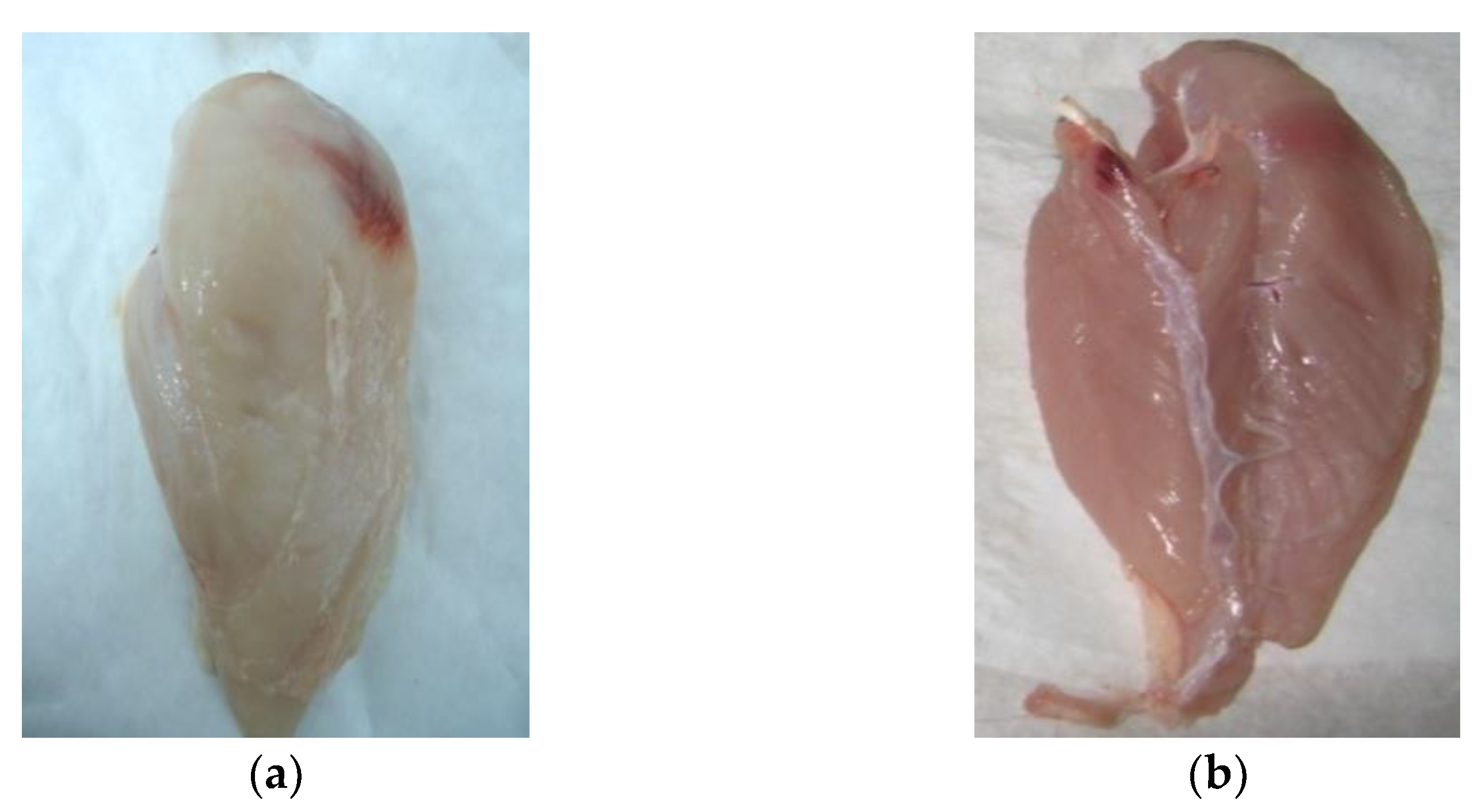

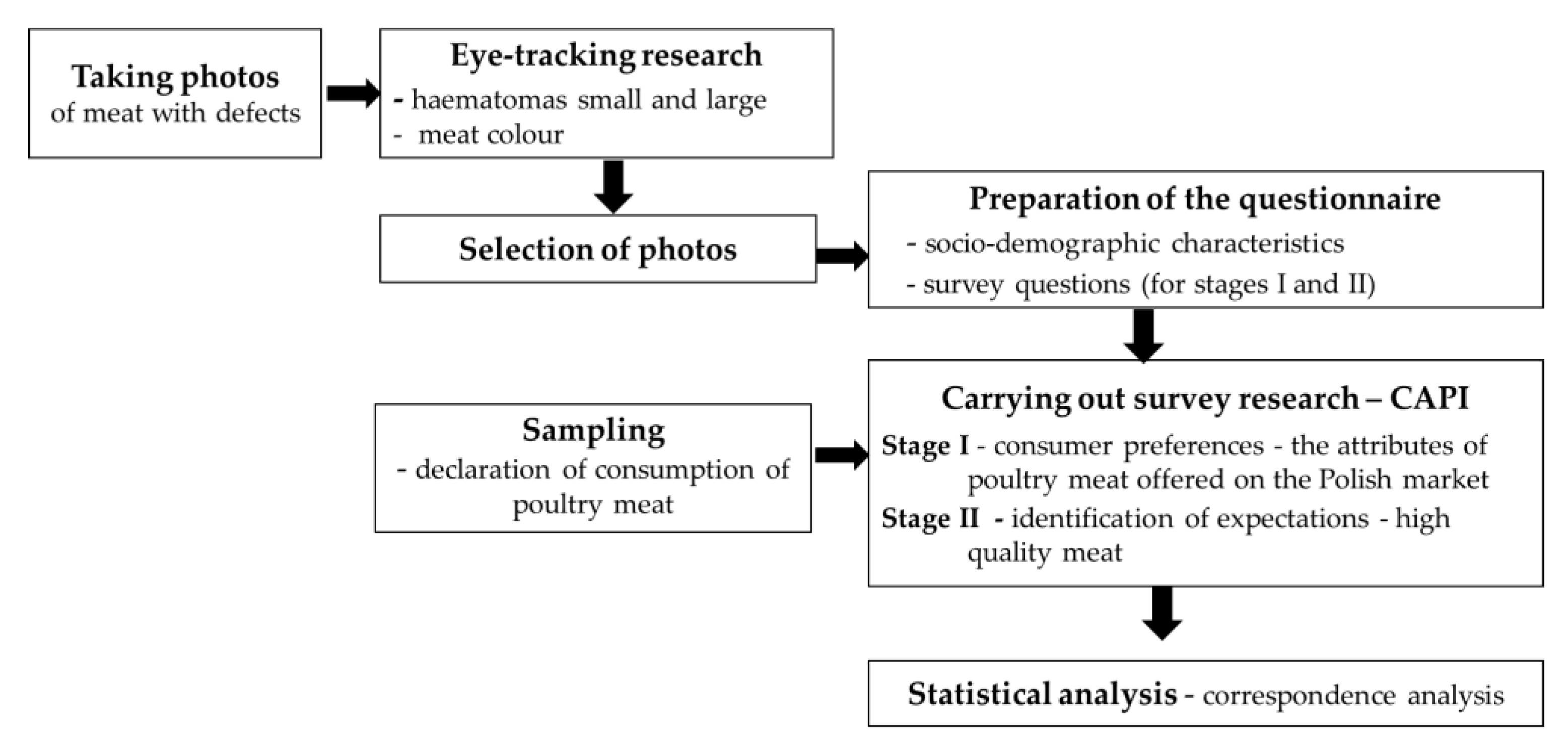
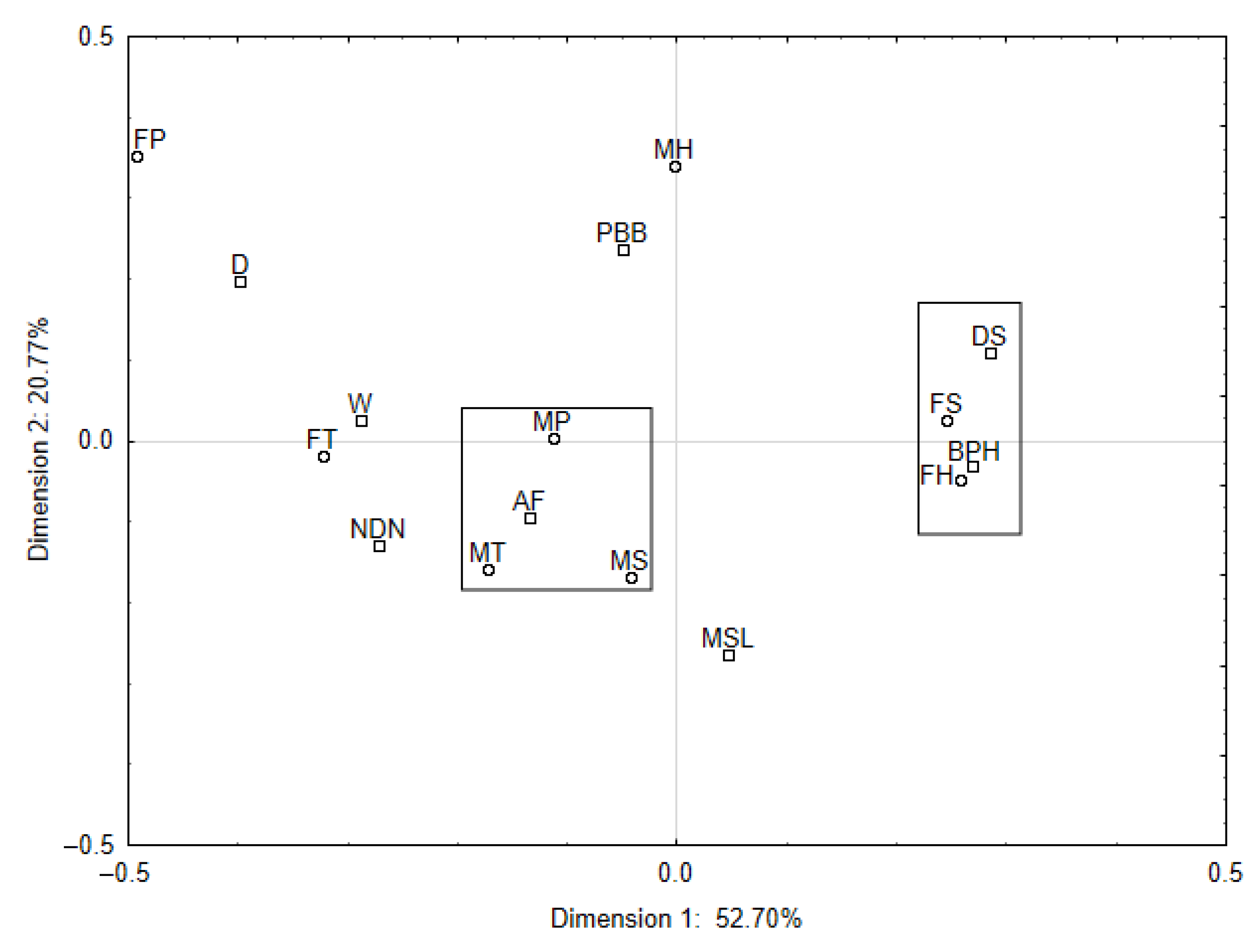
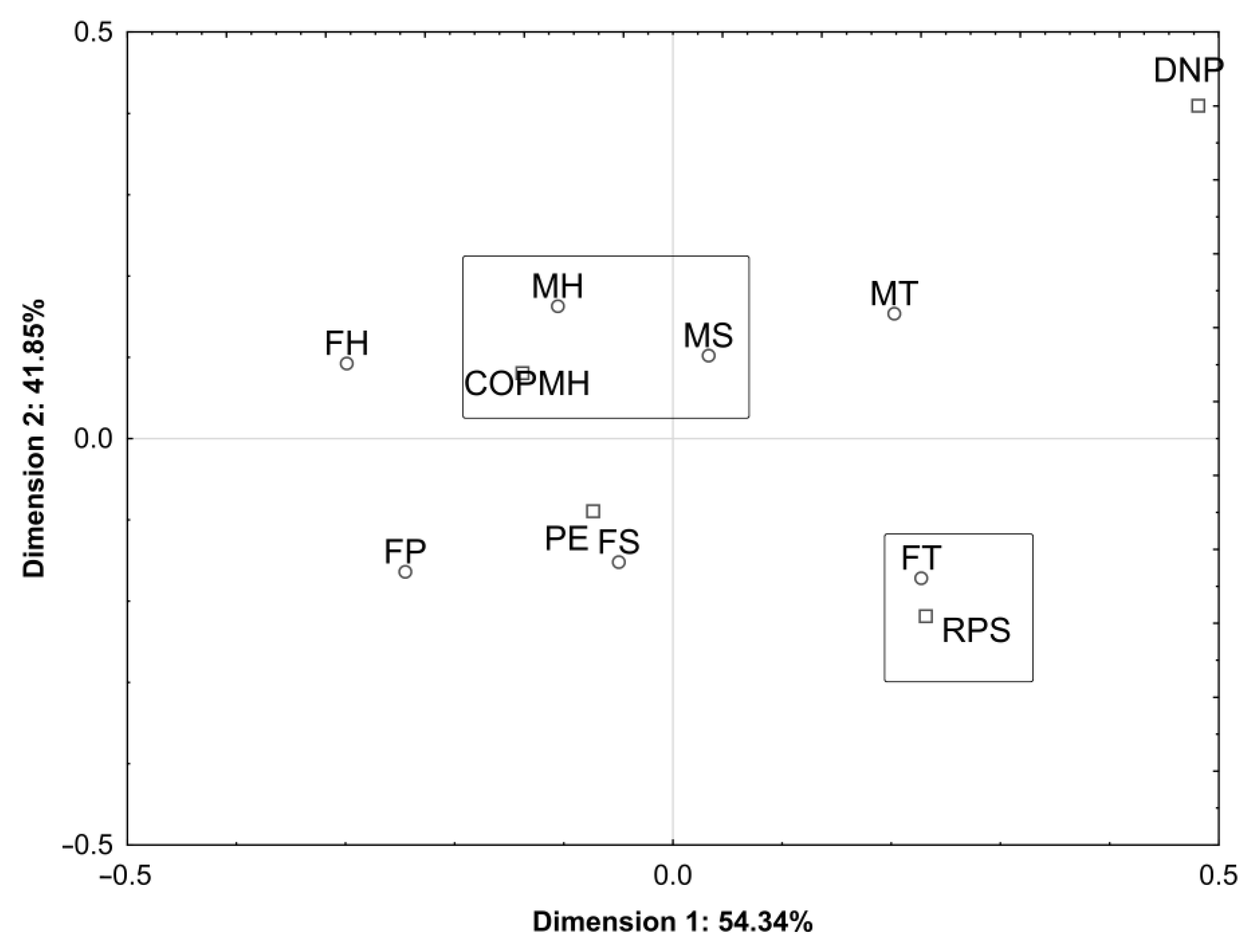
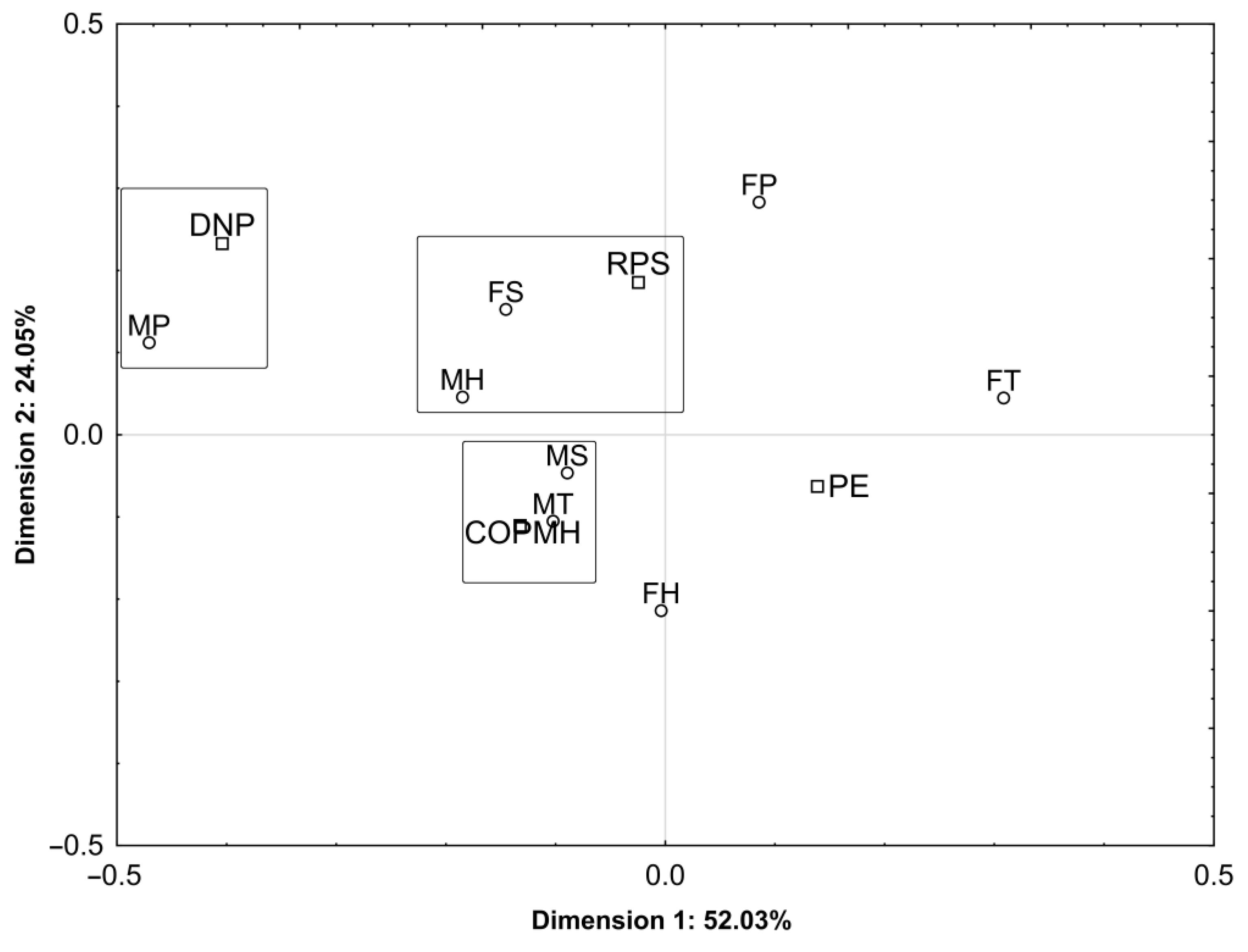
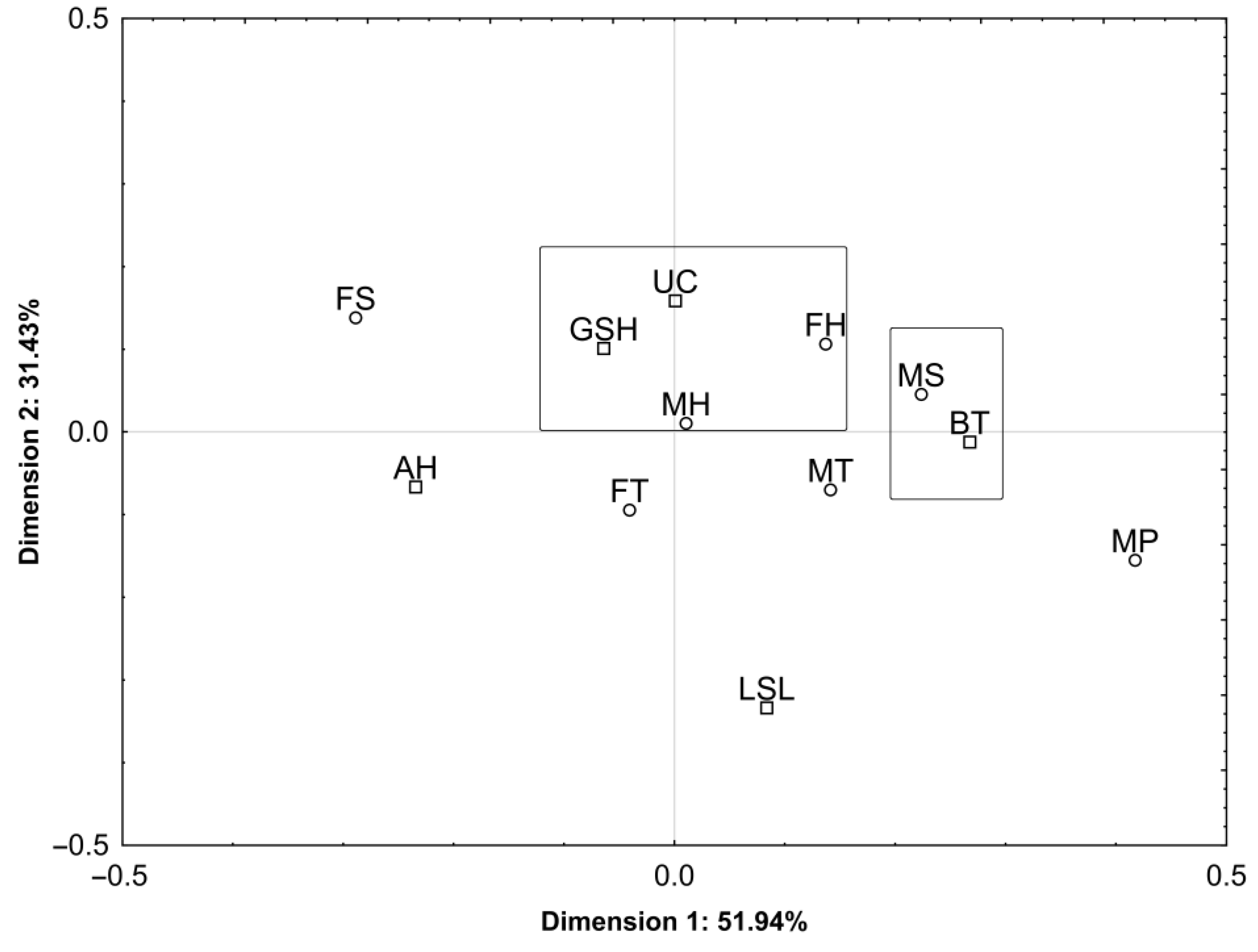
| Stage of Proceedings | Description |
|---|---|
| The recruitment of respondents | Recruitment of participants of the customer survey in stores with poultry meat offer. Involve students in recruiting volunteers and gather contact information. |
| The selection of respondents | The elimination of respondents who were not consumers of poultry meat. |
| The selection of the test sample | The determination of the population of 739 respondents, taking into account the structure by gender. The characteristics of the recruited population of respondents consuming poultry meat were assessed and a comparison of the population of respondents recruited for the study with the characteristics of Poles consuming poultry was performed. |
| The construction of research tools | The classification of hematomas. The identification of types of hematomas present in batches of poultry meat which is on offer on the market: production plants—interviews with commodity experts; retail—interviews with sellers. |
| The standardization of perception of hematoma size | Stage I—the preparation of photos presenting the types of hematomas occurring in the production process. Stage II—the recruitment of experts from the group of consumers declaring the consumption of poultry meat to determine (standardize) the diagnosis of hematomas by consumers participating in the study. Stage III—the preparation of photos for the pilot study. |
| Designing an experiment | Stage I—as a result of the pilot study, the most commonly used names in relation to the hematomas presented in the pictures were selected. Stage II—the preparation of a questionnaire, which was used in a pilot study on a group of 40 respondents recruited from the market. Stage III—after the correction of the questionnaire, the assignment was carried out in a group of 739 respondents. After substantive verification, 595 correctly completed questionnaires were accepted for analysis. |
| Research implementation | Carrying out interviews with poultry meat consumers. |
Disclaimer/Publisher’s Note: The statements, opinions and data contained in all publications are solely those of the individual author(s) and contributor(s) and not of MDPI and/or the editor(s). MDPI and/or the editor(s) disclaim responsibility for any injury to people or property resulting from any ideas, methods, instructions or products referred to in the content. |
© 2023 by the authors. Licensee MDPI, Basel, Switzerland. This article is an open access article distributed under the terms and conditions of the Creative Commons Attribution (CC BY) license (https://creativecommons.org/licenses/by/4.0/).
Share and Cite
Grzybowska-Brzezińska, M.; Banach, J.K.; Grzywińska-Rąpca, M. Shaping Poultry Meat Quality Attributes in the Context of Consumer Expectations and Preferences—A Case Study of Poland. Foods 2023, 12, 2694. https://doi.org/10.3390/foods12142694
Grzybowska-Brzezińska M, Banach JK, Grzywińska-Rąpca M. Shaping Poultry Meat Quality Attributes in the Context of Consumer Expectations and Preferences—A Case Study of Poland. Foods. 2023; 12(14):2694. https://doi.org/10.3390/foods12142694
Chicago/Turabian StyleGrzybowska-Brzezińska, Mariola, Joanna Katarzyna Banach, and Małgorzata Grzywińska-Rąpca. 2023. "Shaping Poultry Meat Quality Attributes in the Context of Consumer Expectations and Preferences—A Case Study of Poland" Foods 12, no. 14: 2694. https://doi.org/10.3390/foods12142694
APA StyleGrzybowska-Brzezińska, M., Banach, J. K., & Grzywińska-Rąpca, M. (2023). Shaping Poultry Meat Quality Attributes in the Context of Consumer Expectations and Preferences—A Case Study of Poland. Foods, 12(14), 2694. https://doi.org/10.3390/foods12142694






